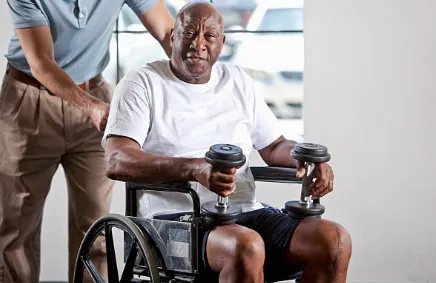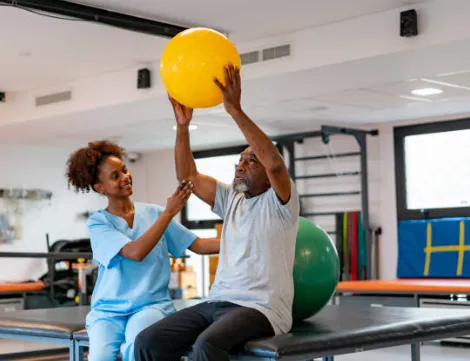Occupational Therapy
What is occupational therapy?
Occupational therapy is a form of therapy that helps patients recuperate from an illness, physical injury, or disability through the therapeutic performance of daily activities.
Examples of these activities include:
✔ Eating without others’ help
✔ Taking a bath
✔ Getting dressed
✔ Brushing your teeth
✔ Going to the bathroom
✔ Cleaning and cooking
✔ Moving around (sitting, walking, standing)
✔ Doing job-related activities
Our occupational therapist can help patients by creating individualized interventions that aim to prevent, develop, or regain skills and body functions.


Which activities are done during Occupational Therapy
Occupational therapy usually has three stages:
✔ Assessment
During an individualized assessment, the occupational therapist helps the patient to determine their needs and goals. The information is used to create an intervention plan that specifically caters to the patient’s individual needs.
✔ Interventions
The occupational therapist helps the patient perform the activities detailed in the customized intervention plan. The plan consists of carefully chosen activities that are related to or can prepare the patients for actual activities they will be doing after rehabilitation. These daily activities are designed to improve the patient’s ability to do everyday activities.
✔ Evaluations and Outcomes
The outcome is evaluated to determine if the goals are being met. The occupational therapist also evaluates if there is a need to make changes in the plan or add therapeutic interventions.
Who needs Occupational Therapy?
Patients who had a musculoskeletal injury can regain and relearn skills needed to perform activities of daily living through occupational therapy. Musculoskeletal injuries are injuries to the bones, fascia, cartilage, ligaments, muscles, and tendons such as:
✔ Arthritis
✔ Bone fracture
✔ Bursitis
✔ Carpal tunnel syndrome
✔ Fasciitis
✔ Sprains and strain
✔ Nerve compression syndrome
✔ Tendonitis
✔ Tennis elbow
✔ Tendonitis
✔ Nerve compression syndrome


What are the Benefits of Occupational Therapy as a form of rehabilitation?
Occupational therapy is a good option for you if you want to experience the following benefits:
✔ Boost patient motivation. Patients are more
motivated to participate in therapy because they
can see the relationship between the
interventions planned by the occupational
therapist and their ability to participate in daily
activities.
✔ Maintain roles and habits. Patients can preserve
and continue to perform their desired roles and
functions within their family and community.
✔ Give patients autonomy. Occupational therapists
can give patients activities to perform at home in
addition to the exercises performed at the clinic.
What is included in an occupational therapy care plan?
Stonestar Health plan of care is customized to the patient’s conditions, needs, and goals after rehabilitation. It may include the following:
Therapeutic activities and exercise
Orthosis design, creation, fitting, and training
Energy modification in home, work, or school
Sensory re-education
Mirror therapy
Hand-eye coordination
Scar and pain management
Work conditioning or work hardening to help patients return to work.
Activities of daily living
Ne and gross motor skills
Use of adaptive or assistive devices like wheelchairs
Post-surgical or post-injury safety education
Fall prevention
Talk to our occupational therapists to get an individualized therapy care plan designed to regain your function, meet your goals, and improve your quality of life.



Facebook
Instagram
X
LinkedIn
Youtube
TikTok